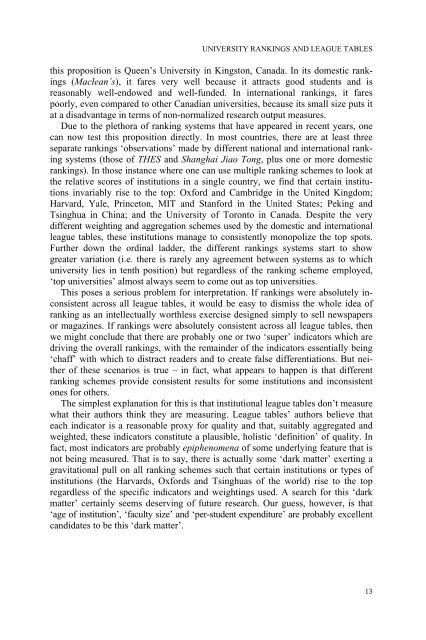University Rankings, Diversity, and the New ... - Sense Publishers
University Rankings, Diversity, and the New ... - Sense Publishers
University Rankings, Diversity, and the New ... - Sense Publishers
You also want an ePaper? Increase the reach of your titles
YUMPU automatically turns print PDFs into web optimized ePapers that Google loves.
UNIVERSITY RANKINGS AND LEAGUE TABLES<br />
this proposition is Queen’s <strong>University</strong> in Kingston, Canada. In its domestic rankings<br />
(Maclean’s), it fares very well because it attracts good students <strong>and</strong> is<br />
reasonably well-endowed <strong>and</strong> well-funded. In international rankings, it fares<br />
poorly, even compared to o<strong>the</strong>r Canadian universities, because its small size puts it<br />
at a disadvantage in terms of non-normalized research output measures.<br />
Due to <strong>the</strong> plethora of ranking systems that have appeared in recent years, one<br />
can now test this proposition directly. In most countries, <strong>the</strong>re are at least three<br />
separate rankings ‘observations’ made by different national <strong>and</strong> international ranking<br />
systems (those of THES <strong>and</strong> Shanghai Jiao Tong, plus one or more domestic<br />
rankings). In those instance where one can use multiple ranking schemes to look at<br />
<strong>the</strong> relative scores of institutions in a single country, we find that certain institutions<br />
invariably rise to <strong>the</strong> top: Oxford <strong>and</strong> Cambridge in <strong>the</strong> United Kingdom;<br />
Harvard, Yale, Princeton, MIT <strong>and</strong> Stanford in <strong>the</strong> United States; Peking <strong>and</strong><br />
Tsinghua in China; <strong>and</strong> <strong>the</strong> <strong>University</strong> of Toronto in Canada. Despite <strong>the</strong> very<br />
different weighting <strong>and</strong> aggregation schemes used by <strong>the</strong> domestic <strong>and</strong> international<br />
league tables, <strong>the</strong>se institutions manage to consistently monopolize <strong>the</strong> top spots.<br />
Fur<strong>the</strong>r down <strong>the</strong> ordinal ladder, <strong>the</strong> different rankings systems start to show<br />
greater variation (i.e. <strong>the</strong>re is rarely any agreement between systems as to which<br />
university lies in tenth position) but regardless of <strong>the</strong> ranking scheme employed,<br />
‘top universities’ almost always seem to come out as top universities.<br />
This poses a serious problem for interpretation. If rankings were absolutely inconsistent<br />
across all league tables, it would be easy to dismiss <strong>the</strong> whole idea of<br />
ranking as an intellectually worthless exercise designed simply to sell newspapers<br />
or magazines. If rankings were absolutely consistent across all league tables, <strong>the</strong>n<br />
we might conclude that <strong>the</strong>re are probably one or two ‘super’ indicators which are<br />
driving <strong>the</strong> overall rankings, with <strong>the</strong> remainder of <strong>the</strong> indicators essentially being<br />
‘chaff’ with which to distract readers <strong>and</strong> to create false differentiations. But nei<strong>the</strong>r<br />
of <strong>the</strong>se scenarios is true – in fact, what appears to happen is that different<br />
ranking schemes provide consistent results for some institutions <strong>and</strong> inconsistent<br />
ones for o<strong>the</strong>rs.<br />
The simplest explanation for this is that institutional league tables don’t measure<br />
what <strong>the</strong>ir authors think <strong>the</strong>y are measuring. League tables’ authors believe that<br />
each indicator is a reasonable proxy for quality <strong>and</strong> that, suitably aggregated <strong>and</strong><br />
weighted, <strong>the</strong>se indicators constitute a plausible, holistic ‘definition’ of quality. In<br />
fact, most indicators are probably epiphenomena of some underlying feature that is<br />
not being measured. That is to say, <strong>the</strong>re is actually some ‘dark matter’ exerting a<br />
gravitational pull on all ranking schemes such that certain institutions or types of<br />
institutions (<strong>the</strong> Harvards, Oxfords <strong>and</strong> Tsinghuas of <strong>the</strong> world) rise to <strong>the</strong> top<br />
regardless of <strong>the</strong> specific indicators <strong>and</strong> weightings used. A search for this ‘dark<br />
matter’ certainly seems deserving of future research. Our guess, however, is that<br />
‘age of institution’, ‘faculty size’ <strong>and</strong> ‘per-student expenditure’ are probably excellent<br />
c<strong>and</strong>idates to be this ‘dark matter’.<br />
13














